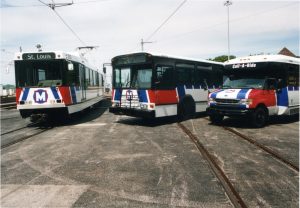St. Louis regional planners want coordinated transit system
By Bob Pieper For Chronicle Media — May 18, 2016

Expansion of Call-a-Ride services is among the proposals in the draft St. Louis Region’s Coordinated Human Services Transportation Plan (CHSTP). (Photo courtesy: Bi-State Development Agency)
The East-West Gateway Council of Governments (EWGCOG) is seeking input on ways to improve public transportation for older adults and the disabled across the St. Louis region.
The agency plans to formally propose its new St. Louis Region’s Coordinated Human Services Transportation Plan (CHSTP), later this year.
A draft version of the plan, released this month, inventories the existing public transportation infrastructure across the seven-county St. Louis region, including Metro-East.
It also suggests goals for improving transportation across the region and outlines strategies for achieving them.
The planning council is accepting public comment on the draft’s various goals and strategies now through Monday, June 13. The council is also seeking proposals for specific projects to meet its proposed coordinated transportation goals.
A public open house on the proposed coordinated transportation plan will be held on Thursday, May 26, 2016 in the EWG headquarters in Downtown St. Louis.
The coordinated transportation plan is designed to fulfill requirements established under the federal Moving Ahead for Progress in the 21st Century Act (MAP-21), as well as the recently adopted Fixing America’s Surface Transportation (FAST) Act. The legislation requires transportation planners to give special consideration to the mobility issues faced by older adults and persons with disabilities.
The council’s new Where We Stand, 7th Edition –Update 2 – Seniors and Aging report, released April 27, notes that the St. Louis region already has the eighth highest percentage of older adult population in the nation.
Across Metro-East, senior citizens represent a growing percentage of the population (see Metro-East Briefs). A significant percentages of those older adults do not own vehicles. Many have disabilities or other health problems. Many may need to work to help make ends meet, the report notes.
Moreover, a sizeable percentage of older adults and persons with disabilities do not have adequate access to public transportation, the CHSTP analysis finds.
Public transportation users most commonly live or work within a half mile-and-a-half of a public transit line. The analysis finds most of the area’s older adults and disabled persons reside well outside the normal public transit “catchment area.”
Currently, more than 50 entities across the St. Louis region play a role in providing transportation for older adults and the disabled.
They range from major mass transit providers, such as the Bi-State Development Agency and Madison County Transit, to social service agencies such as the Area Agency on Aging of Southwestern Illinois and its affiliated local senior citizen organizations.
EWGCOG planners hope new alliances among those entities, coupled with new technology, can expand access to transportation for older adults and the disabled – as well as improve cost efficiency.
The council hopes to fund improvements through initiatives like the federal Enhanced Mobility for Seniors and Individuals with Disabilities programs, which provide capital assistance to nonprofit organizations and public agencies to meet the special needs of the elderly and disabled when public transportation services were unavailable, insufficient, or inappropriate.
EWGCOG planners acknowledge their top goal will be simply sustaining the region’s existing public transportation services. The agency’s long-range Regional Transport Plan 2040 last year noted that the Bi-State Development Agency — which operates the light rail system as well as bus lines in St. Clair County, the City of St. Louis, and St. Louis County — does not presently have sufficient funding to maintain its fleet.
The planning council’s draft transportation plan proposes expanded state and federal funding, as well as public-private partnerships, to maintain or replace existing public transit vehicles.
However, planners also place high priority on new or expanded service for underserved geographic areas and populations, including those on Metro-East.
Among other measurers, the draft proposes voucher programs, expanded volunteer driver programs, increased off-peak transit service hours, and expanded door-through-door assisted transportation services.
The draft also proposes new education and outreach programs to increase awareness of available transportation options. It proposes a new committee of local mobility managers and transportation providers to discuss issues such as referrals, centralized information system, shared maintenance, consolidated dispatching functions, and joint training initiatives.
The draft also proposes further updating of mass transit vehicles to accommodate persons with disabilities and efforts to encourage “walkable” neighborhoods.
The complete draft coordinated transportation plan can be accessed at www.ewgateway.org/ Comments on the plan can also be submitted by email at CHSTP@ewgateway.org.
AT A GLANCE
A public open house on the proposed St. Louis Region’s Coordinated Human Services Transportation Plan (CHSTP) will be held on Thursday, May 26, 2016 in the EWG headquarters in Downtown St. Louis.
— St. Louis regional planners want coordinated transit system —







